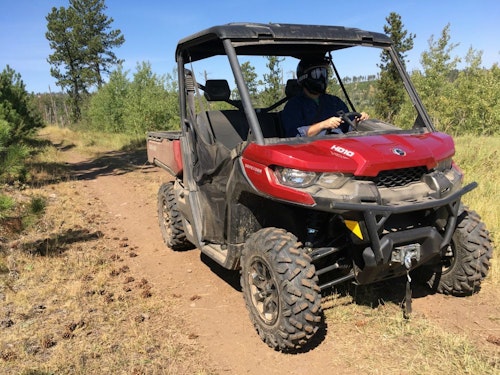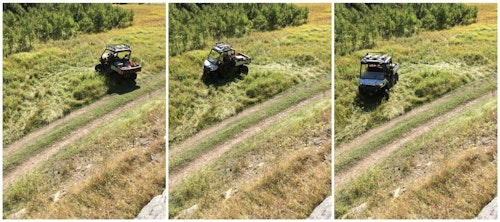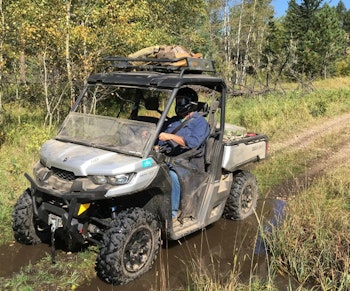Like most of you, a large percentage of my time on ATVs and side-by-sides is spent at slow speeds on old logging roads to and from whitetail hunting areas. I usually have my bow or gun case strapped to the rack of an ATV or in the cargo box of a UTV, and my top speed is 15 mph. As long as the unit starts in any weather (think minus 20 degrees in Minnesota) and then carries my carcass — and occasionally that of a whitetail —through woods, swamps and mud holes, I don’t complain.
I mention this bit of background because — as I ripped along the rugged, steep trails in South Dakota’s Black Hills National Forest — one thought kept creeping to the front of my bouncing brain: This trail system would destroy my four-wheelers.
While it’s true my aging ATV and side-by-side are firmly planted on the “utility” side of the sport/utility fence, the machines I was test-driving in SoDak, the 2019 Can-Am Outlander XT (ATV) and Defender XT (side-by-side), also fall into this same classification. So what made these machines superior to those in my garage? Glad you asked.
“We’re Built for This”
As I paged through the 2019 Can-Am print catalog during my flight to Rapid City, South Dakota, I couldn’t help but notice the slogan on the front cover, “We’re Built for This.” Surrounding these words were photos of machines in the field and the people who ride them. I’m no cover model, that’s for sure, but the guys featured looked like me and other members of my hunting party. Of course, you can’t judge a book by its cover, so I was very interested to see how the newest Can-Am Outlander XT and Defender XT would perform in difficult conditions.
“Hi Dave, my name is Tony Smedsrud, and I’ll be your trail guide. The temps are perfect today for riding; not too hot, not too cold.”
As Tony spoke to our group of four riders, I learned that he’s a veteran who served in the U.S. Army during Operation Iraqi Freedom. He grew up near my home in Minnesota, but he moved out to the Black Hills in the early 2000s to work as an ATV/UTV trail guide. I’m a 7:30 a.m. to 5 p.m. Monday to Friday desk jockey, so I was a bit envious that he spends his weekdays on four-wheelers while ride a swivel chair in front of a laptop. To book a guided trip with Tony Smedsrud, visit www.blackhillsatvguide.com.
Andrew Howard of Howard Communications had planned the media event on behalf of Can-Am, and after providing a quick overview of the machines, he encouraged us writers and editors to provide honest feedback to him and our readers: “The people who read your magazines and visit your websites do so because they want helpful information. Run these machines hard today. Don’t worry ... Tony will have no trouble setting a fast pace if that’s what you desire, and the terrain at times will be challenging.
“Be safe, have fun, and I encourage you to test more than one ATV and side-by-side throughout the day. We’ll have two of the 2019 Can-Am Defender XTs on the trail, as well as three Outlander XTs. Specifically, the Defenders have the HD10 engine; for Outlanders, we have one 650 and two 850s.”

First Ride: Can-Am Defender XT
With helmet and goggles secure, I played follow the leader from our base at High Country Guest Ranch (www.highcountryranch.com) to the trailhead. I called dibs on one of the Can-Am Defender XT side-by-sides; my plan was to save my energy (and more physical ATV driving) for later in the day.
You can visit Can-Am’s website (www.can-amoffroad.com) to read every line item about the Defender XT, so I’ll simply highlight those items that really jumped off the trail at me.
The adjustable tilt steering matched with an adjustable driver seat enabled me to customize the cab of the UTV perfectly for my size and driving needs. On a side-by-side, I prefer a low-position steering wheel and a short reach to the gas and brake pedals, and this was simple on the Defender XT.
The machine’s Dynamic Power Steering (DPS), Electronic Hill Descent Control and choice of three driving modes (ECO/Work/Normal) enabled me to safely and efficiently navigate the varied terrain in the Black Hills. While I spent most of my time with the UTV in Normal mode, I experimented a bit with ECO and Work to understand their applications. It’s a smart system.

With 10 inches of travel on the front and rear suspension, plus 11 inches of ground clearance, the Defender XT eats up everything in its path. Hundreds (thousands?) of times I approached isolated rocks the size of bowling balls in the trail, and early on during our ride I cringed. Why? Because such obstacles would have damaged my at-home UTV — badly. But as I listened for the horrible sound of a boulder smashing the machines’ underside, or feeling it lose traction on the trail, the Defender XT simply floated over the top. Of course, I learned to steer around the really big obstacles, but it was comforting to know that the Defender XT could clear almost anything in its path.
Smart storage. Okay, I know what you’re thinking ... he’s not really going to highlight storage, is he? Yes sir. And the reason is because I’ve never seen anything like it before. The glove box is actually a water-resistant tool box, measuring 1.7 gallons in capacity, and it’s removable. Clever! And it gets better: Beneath the truck-like flip-up VERSA-PRO bench seat is a larger sealed/waterproof storage compartment that also can be removed from the machine.

Another feature I liked was the Adventure Roof Rack accessory mounted to one of our Defender XTs. Capable of toting up to 75 pounds of gear, this rack was ideal for carrying our group’s soft packs that eventually became stuffed with extra clothing after temps climbed from 48 to 78 degrees. The Can-Am engineers were having a good day when they came up with these smart storage features.

First Ride: Can-Am Outlander 850 XT
After a short break for lunch, I switched rides to a 2019 Can-Am Outlander XT 850 ATV. Within seconds after hitting the trails, I was smiling ear to ear. Make no mistake: Driving a side-by-side is fun, but you simply can’t ride one like you can an ATV. Perhaps it goes back to my youth in Minnesota where winters were spent on lightweight Ski-Doo snowmobiles, but the feel of using your own body weight to help steer a machine through the turns is something you can’t do while sitting in a UTV. And the same is true for standing upright on an ATV or snowmobile when encountering uneven and unpredictable terrain at relatively high speeds. I enjoy letting my legs work as additional shocks. In a word — fun.
The Outlander XT comes in three engine sizes: 650, 850 and 1000R. We had the 650 and 850 on the trail system in the Black Hills. All three models have the same length/width/height (86 x 48 x 49.5 inches), wheelbase (51 inches), ground clearance (11 inches), suspension (9.2 inches of travel in front, 9.9 inches in rear) and seat height (34.5 inches), but they differ slightly in weight. The 650 weighs 749 pounds (dry weight); the 850 is 800 pounds, and the 1000R is 826 pounds.

As I stated earlier, I began my afternoon on the Outlander 850 XT. While I have substantial experience riding ATVs for work and play (hunting is blend of both, I suppose), most of my time has been on smaller machines (400s, 450s and 500s). Sure, I’ve driven bigger engines at other media events, but even so I wasn’t prepared for the performance of the Outlander 850 XT.
I can think of no other way to describe this: The 78hp Rotax V-twin, liquid-cooled 854cc engine sounds pissed off. Angry. Really angry. At 20 mph, the engine growl seems to imply, “You have to be kidding me.” At 30 mph, the deepening growl says “Finally, Mr. Driving Miss Daisy, you’re beginning to wake up.” At 40 mph, the engine is just beginning to show its true capabilities. Now, I confess to not feeling comfortable taking the machine to much over 50 mph on the gravel straightaways in SoDak, but I can tell you that the 850 engine wasn’t anywhere close to sounding maxed out.
We didn’t have the Can-Am Outlander 1000R XT available during our trail ride, and it’s probably just as well. I can’t imagine adding 13 more horsepower (from 78hp in the 850 to 91hp in the 1000R) while adding only 26 pounds in overall weight. The 850 was everything I wanted, and I didn’t feel like I really scratched the surface of what it was capable of delivering. The 1000R must be like riding a rocket — and maybe that’s what the “R” signifies?

First Ride: Can-Am Outlander 650 XT
After spending a couple hours on the 850, I switched ATVs with guide Tony, who had been leading our group with the 650 since sunrise. “I think you’ll like it,” is all I said, not wanting to influence his opinion on the larger engine.
Other than being 51 pounds lighter, the 650 is identical in size to the 850, so the overall riding experience is very similar. My goal was to focus on the engine itself; could I easily distinguish between the 62hp and the 78hp offerings? Absolutely.
While the 650 is not a small ATV by any measure, and while it certainly has more than enough speed, power and acceleration for any hunter (or food plot builder) in the field, when it comes to pure trail riding, the difference is noticeable. Earlier I attempted to describe the 850’s engine sound as “pissed off” and “angry”; the 650 doesn’t share these attributes. It’s still a high-performance engine capable of an incredible ride; the 650 just sounds more civilized.
Now that I didn’t have to focus on engine speed and sound, I put my attention to the ride itself. Like I said, the 650, 850 and 1000R all share the same features, so let me detail a couple of them here.
BRP (Bombardier Recreational Products) recently announced updates to the model year 2019 Outlander platform. Rather than attempt to paraphrase, I’ll simply quote the company’s statement:
“2019 Can-Am Outlander ATVs have a brand-new suspension, offering better handling, enhanced stability and additional comfort for an entirely new riding experience. All 650cc and up Outlander models feature a brand-new, purpose-built and recalibrated suspension with front arched A-arms, front sway bar and Torsional Trailing arm Independent (TTI) rear suspension that provides additional width and travel. The system is designed for precision handling, extra comfort and enhanced control.”
I’m a hunter and not a dirt track racer, so in layman’s terms I can tell you that both the 650 XT and 850 XT ride exceptionally well. At no time during my stay in South Dakota did I feel the slightest bit out of control, which is saying something considering the rough terrain and many rocks and logs in the trails. And believe me: For much of the time, our group was traveling well over typical “on the way to the Back 40” hunting speeds.
Cost Considerations
One final note: About the only knock on Can-Ams in the past has been their high price when compared to the competition. That said, BRP has dropped the prices of the Outlander 650s and 850s a few hundred dollars from 2018 to 2019 even though the machines have been updated. Can-Ams have never been the least expensive ATVs on the market — and even with the new lower prices they still aren’t in the bottom tier — but in my opinion, the saying, “You get what you pay for,” is true when it comes to off-road machines that take a tremendous beating.










